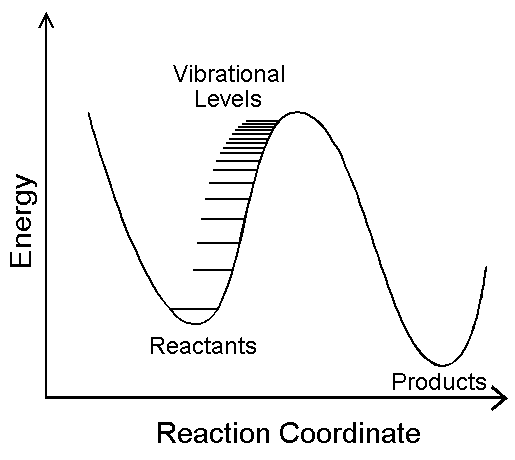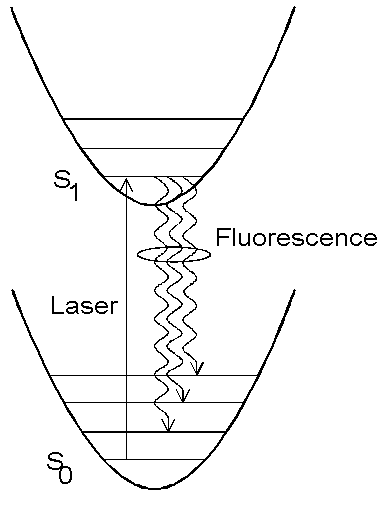
Gregory D. Martin, Todd P. Chassee, Tyson O. Friday, and William F. Polik
Hope College, Holland, MI 49423, USA
http://www.chem.hope.edu/~polik/poster/d2co96.htm
The Potential Energy Surface (PES) provides a fundamental description of a reaction mechanism. The PES can be characterized by measuring the vibrational level spectrum.

At high energies, vibrational transitions are extremely weak and overlapped due to rotational congestion. These difficulties can be overcome by recording DF spectra in a molecular beam.

Rotational congestion is removed by exciting the 000 rotational level of a S1 vibronic level. High sensitivity is achieved because dispersed fluorescence is a zero-background technique. The energies of vibrational levels are given by
Evib = Elaser - Efluorescence
Light, molecules, and detection are the components of DF spectroscopy.

A Nd:YAG laser pumps a tunable dye laser. The laser light is converted to ultraviolet (UV) light, filtered, and directed into the molecular beam chamber. The D2CO molecules are seeded in helium, cooled in a molecular beam, and excited by the UV laser light. The fluorescence is imaged into a monochromator and dispersed onto an Intensified Charged Coupling Device (ICCD) detector. The DF spectrum is analyzed by a computer.
The energy spectrum of D2CO fluorescing from the 000 rotational level in the S1 41 vibronic state is presented below. Vibrational states are observed well above 10000 cm-1 in energy.

Peaks below 3000 cm-1 have been assigned using the H2CO potential energy surface and symmetry-based selection rules.

| Assignment | Experiment | Literature | Theory | Experiment - Theory |
|---|---|---|---|---|
| 00 | 0.6 | 0.0 | 0.0 | 0.6 |
| 41 | 938.7 | 938.0 | 938.5 | 0.2 |
| 61 | 993.7 | 989.3 | 989.2 | 4.5 |
| 31 | 1105.7 | 1100.3 | ||
| 21 | 1702.0 | 1701.6 | 1699.9 | 2.1 |
| 42 | 1867.5 | 1868.7 | -1.2 | |
| 4161 | 1929.8 | 1929.8 | 0.0 | |
| 62 | 1976.3 | 1974.9 | 1.4 | |
| 3141 | 2038.9 | |||
| 11 | 2061.3 | 2055.8 | 2061.0 | 0.4 |
| 3161 | 2072.1 | |||
| 51 | 2163.3 | 2159.7 | 2160.7 | 2.7 |
| 32 | 2201.6 | |||
| 2141 | 2634.7 | 2632.5 | 2.2 | |
| 2161 | 2685.7 | 2684.1 | 1.5 | |
| 43 | 2790.8 | 2791.3 | -0.6 | |
| 2131 | 2797.4 | |||
| 4261 | 2860.8 | 2860.1 | 0.6 | |
| 4162 | 2919.3 | |||
| 63 | 2957.1 | |||
| 3142 | 2968.0 |
Analysis of higher energy peaks is in progress.
Dispersed fluorescence spectroscopy of H2CO has greatly increased knowledge of vibrational level structure in H2CO. Preliminary analysis indicates that similar results can be expected from the current work on D2CO. The increase in known vibrational levels will lead to a much better understanding of the formaldehyde PES.
We gratefully acknowledge stipends from the Dreyfus Foundation and the Hughes Foundation. This research has been sponsored by National Science Foundation grant CHE-9157713.